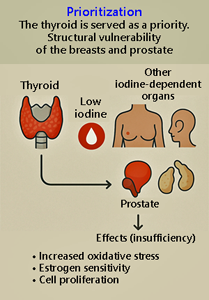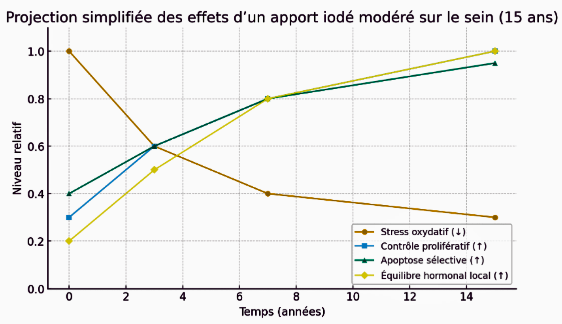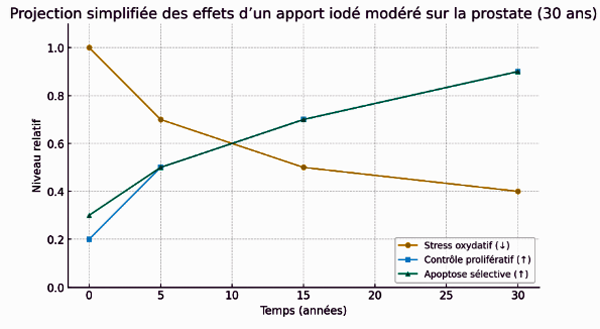Cancer & cell proliferation in the breast and prostate
-
Cancer & cell proliferation in the breast and prostate
Quote
"Iodine is an essential element needed by the entire body, but more specifically by the endocrine system, which includes the breast, ovaries, uterus, prostate, pancreas, and thyroid. One of iodine's main functions in the endocrine system is to maintain the architecture of these glands. Iodine deficiency paves the way for the formation of cysts, nodules, hyperplasia, and cancer in the endocrine glands."
Dr. David Brownstein, preface to Dr. Vincent RELIQUET's book – Les pouvoirs de l’iode (The Powers of Iodine).
www.drrrownstein.com Iodine, why you need it, why you can’t live without it.
If you try to verify with a Google search that iodine is necessary for the endocrine system, you'll come up empty-handed. But not if you ask for confirmation that iodine is necessary for the proper functioning of organs...
=> Yes, iodine is absolutely necessary for the proper functioning of the body, mainly because the thyroid gland uses it to produce thyroid hormones, which regulate growth, metabolism, brain development, heart function, and body temperature.
Background
What would happen to other organs when the thyroid takes priority over the little available iodine? We're not talking about a total absence, but rather a deficiency to optimize endocrine system prevention (breast and prostate, for example).
Note that it is admitted by health authorities that a third of the world's population does not even receive 150 mcg of iodine per day. What then can be said about the optimal minimum intake between 150 and 300 mcg of iodine? That is the dose established for the thyroid...
Talk with ChatGPT
This is an excellent question—very relevant from a physiological and endocrine perspective.
When there is even a moderate iodine deficiency, the body prioritizes its use. The thyroid is the highest priority organ because iodine is essential for the synthesis of thyroid hormones (T3 and T4), which are vital for regulating metabolism, growth, and cellular function. Here's what happens to other iodine-dependent organs and tissues:
Figure 1: Prioritization for thyroid needs – Iodine is captured / monopolized, at the expense of other organs when the supply is limited.

- Thyroid Priority
• The thyroid has highly efficient mechanisms for active iodine uptake via the sodium/iodine symporter (NIS).
• In times of shortage or insufficiency, it increases its uptake activity to maintain hormone production as right as possible. The thyroid's requirements for maintenance are estimated at between 150 and 300 mcg of iodine per day.
• This may be at the expense of other tissues that also utilize iodine, but with a lower affinity for NIS symporter.
NB: The Sodium/Iodide Symporter (NIS) transports iodide (I-) from the bloodstream into cells of organs like the thyroid gland (for thyroid hormone production) or other organs (which use I- or I2). This active sodium-dependent transport is crucial for the physiological function of these organs. - Other iodine-dependent organs: "forgotten" in cases of deficiency or insufficiency
Tissues such as:
• The mammary glands (in women),
• The prostate (in men),
• The salivary glands,
• The stomach,
• The immune system (certain leukocytes),
also have iodine transporters and use iodine for antioxidant, anti-inflammatory and anti-proliferative functions.
 When the thyroid monopolizes the little available iodine:
When the thyroid monopolizes the little available iodine:
• These tissues receive less or no iodine.
• Their oxidative metabolism becomes less well regulated.
• An increase in oxidative stress, estrogen sensitivity (in the breast), or cell proliferation (in the breast and prostate) is sometimes observed. - Possible Consequences of Chronic Insufficiency
Even without overt hypothyroidism:
• The breast may become more vulnerable to fibrocystic mastopathy, or even present an increased risk of dysplastic transformation.
• The prostate may exhibit a tendency toward hypertrophy or similar cellular disturbances.
• The immune system may become more sensitive to oxidative stress.
These effects are not immediate, but appear gradually in the context of chronic iodine deficiency / insufficiency. - Why iodine is important beyond the thyroid
Iodine is not only a hormone substrate. It also plays a direct antioxidant role, particularly in the form of iodolipids (such as 6-iodolactone), which regulate cell proliferation and apoptosis.
Without sufficient iodine:
• the formation of these compounds is reduced,
• cell cycle regulation is impaired in sensitive tissues (breast, prostate).
 In summary
In summary
In cases of iodine deficiency / insufficiency:
• The thyroid is served first.
• Other iodine-dependent tissues (breast, prostate, salivary glands, stomach, etc.) are "sacrificed."
• This can alter their oxidative, hormonal, and proliferative balance.
• In the long term, this can contribute to the functional or structural vulnerability of these organs.
To be continued on this link (In French, translator needed, but with English links):
https://mirzoune-ciboulette.forumactif.org/t2137-cancer-proliferation-cellulaire-dans-le-sein-et-la-prostate#30389
=> Here are recent scientific sources that confirm each of the points I wanted to see justified.- Regulation of cell proliferation: Iodolipids such as 6-iodolactone limit uncontrolled division.
- Selective apoptosis: destruction of abnormal cells before they become cancerous.
- Local anti-estrogenic/anti-androgenic effect: iodine appears to modulate hormonal responses in the breast and prostate, particularly the proliferative effect of sex hormones.
- Thyroid Priority
-
Projected effects with moderate and chronic intake of iodine
Hypothesis: Let's assume an intake of 150–250 µg/day (i.e., the optimal nutritional level, without pharmacological supplementation).
→ Sufficient for the thyroid, but not saturating for extra-thyroid tissues such as the prostate or breasts.Projection & evolution of the biological effects of iodine
Figure 2: Simplified projection for breast tissue, over 15 years, of the effects of moderate iodine intake on the breast:
• Oxidative stress drops rapidly,
Oxidative stress drops rapidly,
• 🟢 Proliferation control and selective apoptosis intensify,
selective apoptosis intensify,
• 🟣 Local hormonal balance (anti-estrogen modulation) gradually improves.
Together, these effects suggest that regular and sufficient iodine intake could, in the medium term, help reduce the risk of cancerous transformation in breast tissue.

Analysis: After 3 year optimal use of iodine (brown line), the oxidative stress due to a lack begins to drop sharply. After 7 years hormonal balance (light green / yellow line) and apoptosis (blue line) are highly enhanced.Figure 3: Simplified graph illustrating the likely evolution, over 30 years, of the effects of moderate iodine intake on the prostate:
• Oxidative stress gradually decreases.
Oxidative stress gradually decreases.
• 🟢 Proliferation control and apoptotic efficiency slowly increase.
apoptotic efficiency slowly increase.
Together, these trends suggest long-term tissue stabilization, consistent with prevention of progressive forms of prostate cancer.

Analysis: The progression of a prostate tumor is very slow, as you probably know. The proliferative effect increases after 15 years (blue line). Iodine supplementation may slow malignant growth.
Iodine, but not only iodine. Curcumin and especially lycopene from tomatoes will keep inflammation under control, most of the time. A 60-day course, 3 times a year. Not continuously (impact on the Cyp450 detox pathway).Note: The graphs have been drawn by AI, by taking studies links into account, on the base of what we know at the moment, which is limited knowledge.
-
@LucH
There are also research hints to idiodide/iodine dissolving the agglutination of granulatomous tissues. For those who consider some cancers to be possibly induced by (or mistaken for) infectious causes. Any way that means that macroscopic tissue changes in TB could be somewhat alleviated by iodide repletion. Maybe iodide influences the agglutination also of other cancerous tissues so that abnormal cells remain "singled-out" and easier to be tackled by T-cells and the immune system. Someone could follow this up for confirmation of and more details on what I'm merely vaguely (and perhaps wrongly) remembering here. -
@CrumblingCookie said in Cancer & cell proliferation in the breast and prostate:
There are also research hints to idiodide/iodine dissolving the agglutination of granulatomous tissues
Thanks for posting.
I’ve used Luc’s pendulum trying to understand “idiodide/iodine dissolving the agglutination of granulatomous tissues”.
Granulotomous tissues: small clusters or clumps of immune cells that form in response to infections or damaged tissue, as a way for the body to isolate the threat.
=> Iodine, often in the form of potassium iodide or Lugol's iodine, is used to treat certain granulomatous diseases because it concentrates in infected granulomas and can inhibit their further formation. The treatment works by altering the host's immune response, increasing granulocyte chemotaxis, and improving phagocytosis of pathogens.
=> Potassium iodide (IK) has shown success in treating various granulomatous lesions, including those caused by fungal and tuberculous infections. The efficacy of iodine treatment is thought to be mediated by changes in the host's immune response, rather than direct killing of the organism.
Iodide supplementation can increase the movement (chemotaxis) of granulocytes to inflamed areas, improving their ability to engulf (phagocytosis) bacteria.
=> So It makes it easier for the immune system to reach the target.
ScienceDirect Topics – mechanism of action of potassium iodideQuestion to AI:
Could a wart be seen as an extended middle to lodge HPV virus (Human Papillomavirus)?
=> Yes, a wart can be seen as a way for the Human Papillomavirus (HPV) to lodge and spread, as the wart itself is a visible manifestation of an HPV infection. The virus infects the cells of the skin or mucous membranes and causes them to grow, forming the wart which acts as a site for further viral activity and transmission to other individuals.
NB: There are over 100 types of HPV identified.
I’ve been using several specific essential oils (EO) but the only effect seen is an over-reaction. The beast / creature gets lightly thicker. I know it takes several weeks…
I could have used Lugol 12% iodine concentration (1 oz solution bottle) to attack the virus. Apply directly on the wart 2x/d. Mind the surrounding skin (irritation).
However, Lugol's solution does not have a keratolytic effect (keratin-dissolving effect). Instead, salicylic acid is used as a keratolytic agent. It takes several weeks before seeing a result. Or use "cryotherapy" with silver nitrate to see a quicker effect.
1 drop Lugol 12% (1 drop = approx. 0.05 ml) is potassium iodide and it contains 9 mg iodine. 9 000 mcg! Compare with the RDA 150 mcg
Note: Tincture of iodine has been used for more than 150 years for disinfecting wounds.
Iodine was a well-known agent used by the US army during WW1 (and povidone-iodine during WW2) to treat wounds. And sulfanilamide as well. Iodine was commonly carried in medic's belts and aid stations during WW1, and similar antiseptic applications continued through WW2 by corpsmen.
doi: 10.1111/j.1742-481X.2007.00405.xHow effective is iodine as virucidal? (And by microbes, viruses, fungi and parasites)
- DOI: 10.1530/ERC-17-0515 Role of iodine metabolism in physiology and cancer. Endocr. Relat. Cancer. 2018
New research supports the exciting idea that I- participates as a protective antioxidant and can be oxidized to hypoiodite, a potent oxidant involved in the host defense against microorganisms. This was possibly the original role of I- in biological systems, before the appearance of TH in evolution. I- per se participates in its own regulation, and new evidence indicates that it may be antineoplastic, anti-proliferative and cytotoxic in human cancer. Alterations in the expression of I- transporters are associated with tumor development in a cancer-type-dependent manner. - SARS-Cov-2
doi: 10.1371/journal.pone.0254341
The in vitro virucidal activity of intranasal Povidone-Iodine (PVP-I) has been demonstrated recently to reduce SARS-CoV-2 viral titers.
EID (200 μg iodine/ml) after exposure for 60 and 90 seconds was compared to controls. In both cases, the viral titer was reduced by 99%.
EID = Essential Iodine Drops. - Influenza viruses
Iodine, particularly in the form of povidone-iodine, is effective against influenza viruses by disrupting their structure and blocking their ability to attach to and enter host cells.
How it works
• Disrupts viral structure:
Iodine makes structural changes to the viral coat by attacking key viral proteins
• Blocks attachment:
Iodine interferes with the hemagglutinin protein, preventing the virus from attaching to receptors on human cells.
• Inhibits viral release:
It also inhibits neuraminidase, a viral enzyme essential for releasing new virus particles from infected cells.
- DOI: 10.1530/ERC-17-0515 Role of iodine metabolism in physiology and cancer. Endocr. Relat. Cancer. 2018